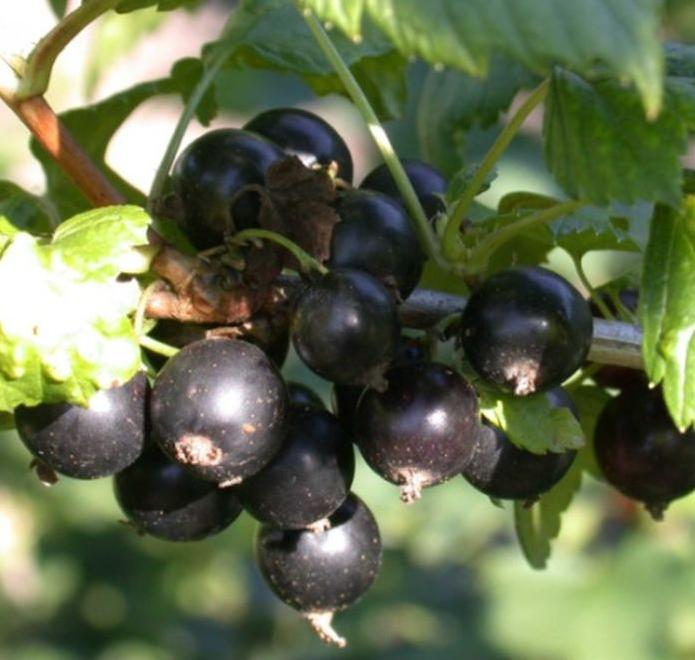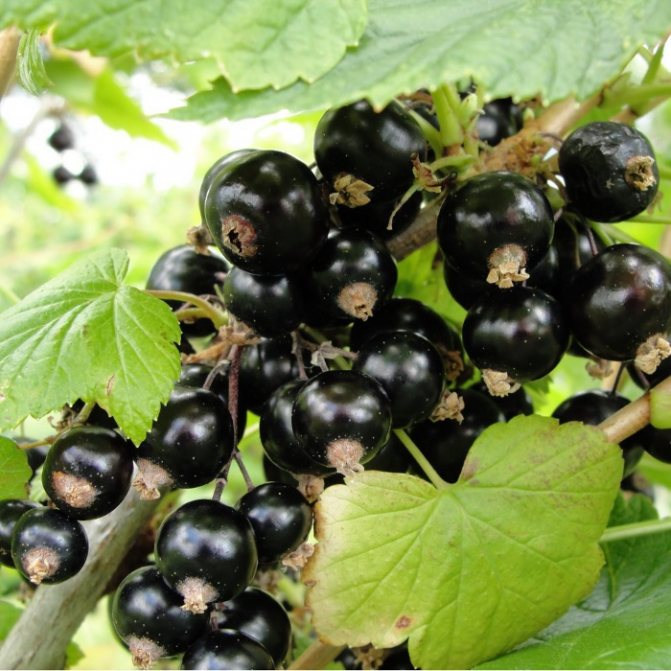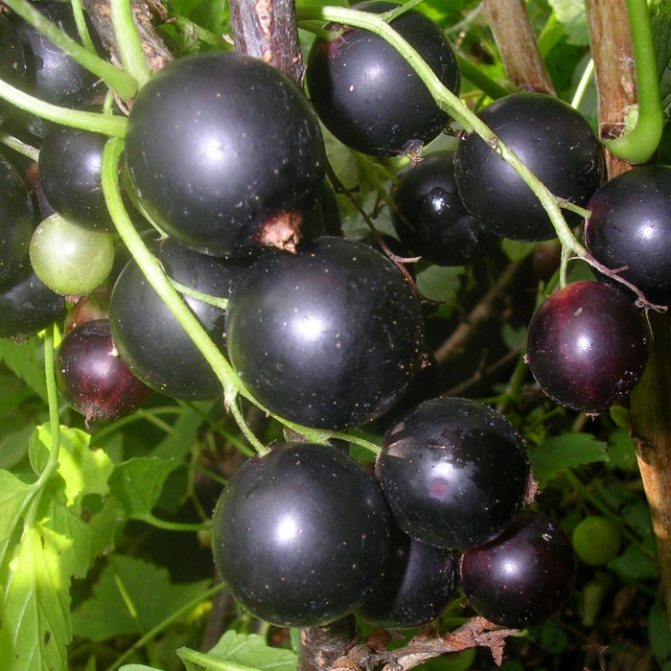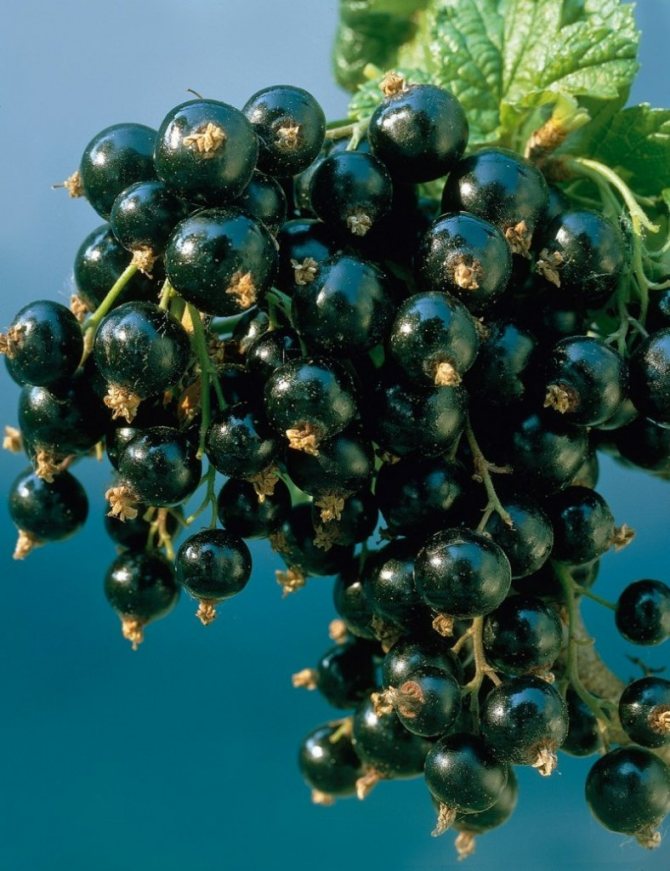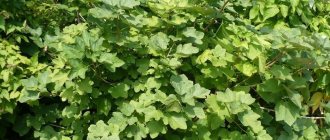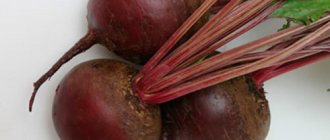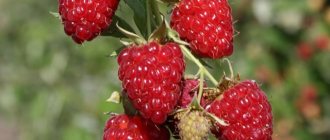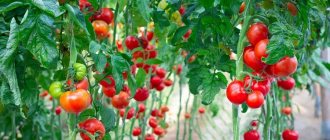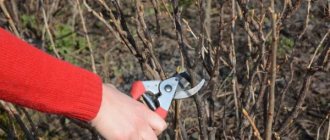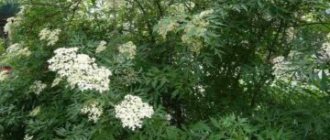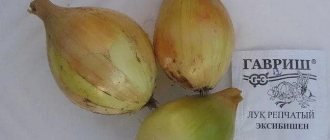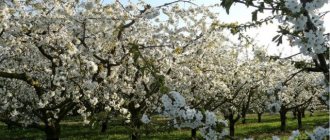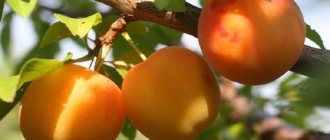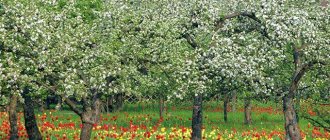Both old and small are familiar with currant berries, but where its name came from, no one knows. Some believe that the bush was named because it emits "currant", that is, a bad smell. Others, on the contrary, say that the name comes from the word "curry". It means that the shrub has a strong, pleasant aroma. But, regardless of the origin of the name, the berries of this shrub were to everyone's liking.
There is probably no such person who would not like to feast on black currants, and in winter times to enjoy the aroma of summer. Therefore, many tend to plant it on their site and look forward to the harvest. But there are times when a gardener buys a seedling based on the description, and as a result, only a few berries grow. What is the reason? What varieties of currants should you choose for the Moscow region?
The best varieties of black currant for the Moscow region and the Chernozem region
Moscow and Chernozem regions are the central part of Russia. Due to the pronounced seasonality (cold winters, warm summers), most plants do not respond to autumn-winter and spring temperature changes.
The soils in these zones are infertile, acidic - fertilizers are applied for growing berries and liming is carried out. The most suitable types of currants for central Russia are Dubrovskaya, Perun and Sevchanka.
Belongs to the best late-ripening varieties. Harvesting is carried out in mid-August, ripe berries are large, sugary, without aroma.
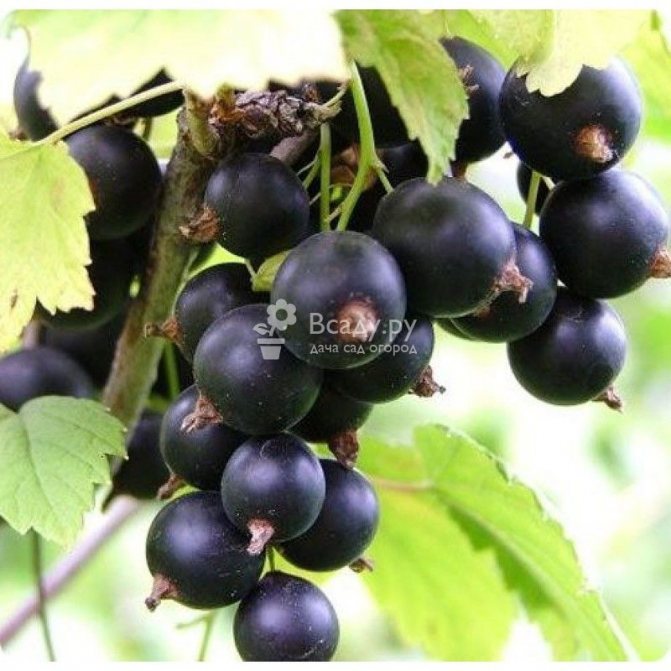
Berries of currant varieties Dubrovskaya
The bushes of Dubrovskaya are low, but voluminous. The approximate yield is 3.6 kilograms of fruit per plant. Dubrovskaya easily tolerates low temperatures in winter, has immunity from the appearance of kidney mites and fungal diseases.
Fruits are sweet, sugary, large - up to 4 g. Berries ripen in the last decade of July.
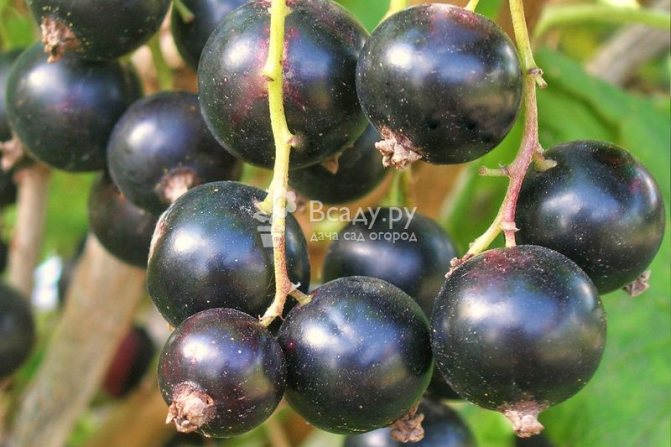

Currant Perun - large-fruited and very sweet
Plants are medium-sized, up to one and a half meters tall, the yield is low, up to 2 kg per bush. Differs in resistance to sharp drops and temperature fluctuations. Not afraid of infection with fungal spores, partially protected from the appearance of ticks.
Sevchanka variety
Black currant large sweet variety Sevchanka is famous for large fruits up to three grams. The pulp is covered with a dense skin that protects the berries during storage and transportation. The taste of the fruit is very sweet, with a barely perceptible sourness. Often used in cooking and winter preparations.


Sweet currant Sevchanka is well stored and disease resistant
Bushes are tall, slightly spreading, give many shoots. They are not afraid of high temperatures, protected from major fungal diseases.
Most of the well-known and beloved black currant varieties bear fruit well in the Moscow region and neighboring regions, including Nizhny Novgorod.
Popular varieties are successfully cultivated here: Dachnitsa, Selechenskaya-2, Dobrynya, Lazy, and many others.
Moscow
On a long brush, large currants are located - 1.3-2.2 grams. The sugar content is 9.8%. The description of the variety allows for a pear-shaped currant.
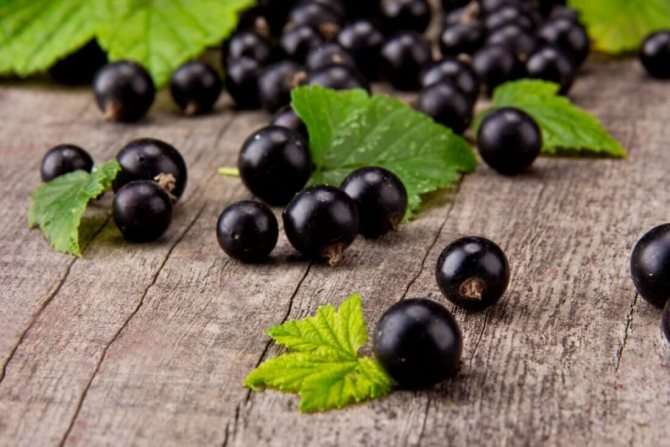

The best harvest is obtained with careful care - top dressing, regular pruning. Collection from a bush - 4 kilograms.
Litvinovskaya
The currant grows in a tall bush, reaching 2 meters. Due to the weak branching, it does not take up much space.
The taste of the berries is sour, since the sugar content is 7%. It spins amicably, the harvest is large - up to 8 kilograms per plant.
Loves not very heavy soils, does not have drought resistance, and requires regular watering. It tolerates frost well.
The climate of the Moscow region is characterized as temperate continental, in which winters are relatively mild, and the warm period of the year is long and rather humid. For the normal vegetation of currants, an important role is played not only by moisture, but also by the type of soil.
In the described region, it is predominantly sod-podzolic, medium loamy, which indicates a tendency to stagnation of wastewater in the upper layers. Waterlogging leads to decay of the root system, and therefore the soil needs liming and enrichment with organic matter.
Criterias of choice
When choosing a variety of currants for growing in the Moscow region, important factors must be taken into account:
- the ability of culture to adapt to the climatic conditions of the region;
- strong immunity to resist common diseases;
- a combination of parameters such as self-fertility, plant and berry size, bush shape, etc.
Preference should be given to those crops that have long been grown in the Moscow region.
Subtleties of care
To achieve maximum success in growing blackcurrants, you must follow the following guidelines:
- It is known that the maximum success of black currant growth is observed in illuminated areas, although in shaded areas the culture grows quite normally. Better to place plantings along the southwest walls;
- For the normal development of currants, you need to ensure balanced watering. Its intensity should be maximal during the prolonged drought, which occurs in the middle of summer. When watering, the sprinkler method should be used;
- Excessive soil moisture is dangerous for the growth of currants. It is important that the groundwater is located no closer than one and a half meters from the roots. In the third year of growth, organic fertilizing, including humus or compost, must be applied under the bush. The optimal rate is half a bucket per bush. Superphosphates and potassium sulfate can be used as fertilizers. Nitrogen-containing substances are introduced every year. Also, one bush accounts for 80 grams of saltpeter. It is known that the currant rhizome is located near the surface itself, therefore, great care must be taken when loosening;
- The planting of currants is started before the budding begins, in the first days of spring. With autumn planting, growth productivity is much better. Landing is carried out according to the scheme of two meters by one and a half. For reproduction, cuttings and the layering method are used. Finally, it is necessary to cut the shoots to the second or third bud.
If you follow all the existing recommendations and rules for caring for currants, you can grow an excellent crop without large investments.
Bagheera
This variety, in addition to the high sugar level in berries (10.8%), has many other advantages. For example, it is recommended for growing in most climatic zones, since it is equally resistant to frost and drought. The bushes are small, medium spreading, rather thickened. The berries are large, round, blue-black, with a sweet and sour taste, which allows them to be consumed both raw and processed. The fruits retain their presentation even during long-term transportation.
| Harvest | Bush height (m) | Berry weight (g) | Productivity (kg per bush) | Shelf life of fresh berries (days) | |
| Mid july | 1,2-1,5 | 1,5-1,7 | 3,5-4 | 14-21 | |
Chose a variety, what's next?
And then you need to purchase it. This is best done in reputable nurseries or specialist gardening stores.So you protect yourself from changing the variety or from acquiring a low-quality seedling infected with fungi or pathogenic microflora.
When buying, you should pay attention to the condition of the root system of the seedling: there must be at least 3 main lignified roots 15-20 cm long.
Important! A two-year-old seedling takes root 100%!
If it is not possible to purchase the variety you like in the nursery, you can get planting material from a growing currant bush. As a rule, this exchange is practiced in gardening partnerships.
The best varieties of black currant for the Moscow region and the Chernozem region
The varieties differ in the following indicators:
- By appointment;
- The speed of fruit ripening;
- The volume of the harvest;
- Taste of pulp;
- Resistant to low temperatures;
- Resistant to diseases and viruses.
By purpose, the fruits are subdivided:
- Dessert variety - berries with excellent taste;
- For preservation and preparation - fruits with soft and delicate skin, sour taste;
- For freezing - thick-skinned currants;
- Universal varieties.
When choosing a variety, you should pay attention to the region in which it is recommended to grow it. Plants suitable for planting in a particular area produce a good harvest.
Weight, ripening time of the crop, taste may differ depending on the area in which the plant was planted and on the composition of the soil or watering. At a distance of more than 200 km, the main characteristics of the berry can vary greatly.
Summer residents for central Russia are advised to choose the following varieties:
- Early ripening - at the end of June: "Exotic", "Dikovinka", "Selechinskaya", "Dachnitsa", "Orlovia", "Openwork";
- The average ripening period is the second half of July: "Fidelity", "Green Haze", "Black Pearl", "Zusha", "Perun";
- Late ripening period - from the second half of July to August: "Rusalka", "Venus", "Kipiana", "Yadrenaya".
Experienced gardeners boldly experiment with new varieties of currants. But for novice summer residents, it is better to choose time-tested varieties of black berries. Any seedling from the options considered below has a better chance of quick adaptation to new conditions and intensive development.
- Dobrynya
Compact plant with large berries. The weight of one reaches 2.6-6 g. The tasting score is 4.8 points. The pulp is dense, contains a lot of juice, the aroma is well felt. Varietal characteristics: self-fertility, high productivity, winter hardiness, inertness to powdery mildew and pests.
The currant bears fruit annually and stably. Strong immunity practically excludes the use of chemicals, inertness can be traced to the most common and dangerous diseases of representatives of the gooseberry family.
Description of fruits: weight 2.9-4.6 g, color dark purple, tasting score 4.9 points. The purpose of the harvest is universal, it is used both fresh and processed. 2.6-2.8 kg of currants are removed from a shrub 3-4 years old.
Large-fruited currants (one weight 3.5-3.7 g), suitable for fresh consumption and processed for winter harvesting. Varietal differences: plant inertness to fungal diseases, pests, frost resistance.
Taste qualities are estimated at 4.5 points, the high sugar content makes it possible to use currants as a dessert. Despite the thin skin, the berries retain their presentation well in a cool place.
The ripening period, the parameters of the bush are characterized by average indicators. The weight of the currant is 1.2-2.3 g. From a plant that is 4-5 years old, 3.6-4 kg are removed. The fruits have a pronounced taste with a pleasant aroma.
Both acid and sugar are felt. The crop is high-yielding with large berries, but shrubs tend to thicken, which often leads to the development of anthracnose and powdery mildew.
Medium-sized bushes of moderate thickening. Harvesting falls in the second half of July.Up to 5 kg of fruits are obtained from one plant. Varietal characteristics: self-fertility, inertness to common diseases, kidney mites, resistance to severe frosts.
The pulp of the berries contains a record amount of vitamin C, but at the same time it is quite sweet in taste, the weight of one is 1.3-1.6 g. Currants are often used by chefs for their masterpieces. Chopped berries mixed with sugar are an excellent vitamin supplement that can be consumed all winter until the next warm season.
Ripe fruits are prone to shedding, so gardeners line the tree trunk with polyethylene or cloth to collect volunteers. In general, currants are unpretentious, but require good irrigation.
A fast-growing variety that gives the first harvest in 2-3 years of life. The shrub develops rapidly, the shoots are semi-spreading. The leaves have tomentose pubescence in the zone of the petiole notch. Fruits hang from 1.6 to 3.5 g. The pulp contains a large number of seeds.
The berry is prone to cracking, in order to avoid crop losses, it is necessary to collect it in a timely manner. The fertility of one plant is 3-4 kg. The variety is self-fertile only by 50%, therefore, it is advisable to plant a pollinator crop near it.
Due to the short growing season, harvesting can be started in the first decade of July. One plant produces 4-5 kg of yield. Features of the variety: drought resistance, winter hardiness, strong immunity.
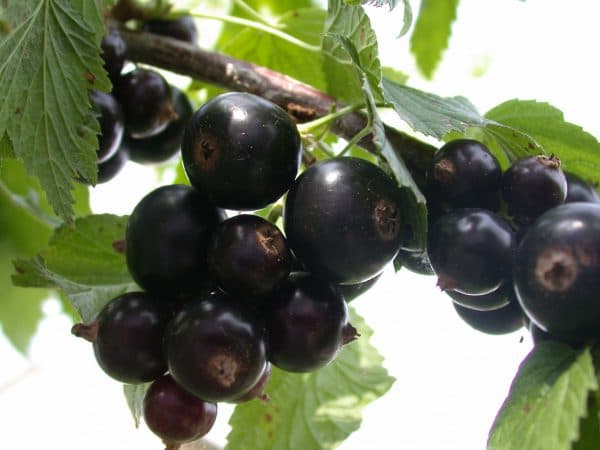

Distinctive features of the fruits: round shape, almost black color, weight of one 4-5 g, there are both acidity and sweetness in the taste. This option can be used for cultivation in any part of Russia.
The crop is harvested from the second half of July to the end of August. Under unfavorable conditions, some of the fruits do not have time to ripen. Brief characteristics of the berry: weight 3 g, black-brown color, sweet flesh on the palate, barely sour taste, pronounced aroma, thin but strong skin.
The plant itself reaches a height of 170-180 cm, the branches are thick straight lines, the leaves are large, slightly wrinkled. The yield from one young shrub does not exceed 2 kg; at 4-5 years of age, the culture generously presents the owners with 10 kg of hearths.
The plant is vigorous with spreading branches. The leaves are wrinkled, three-lobed. The weight of a ripe berry reaches 2.9-4.6 g. The fertility of the bush is about 2.5 kg.
The crop is harvested from the second half of July. The thin but dense skin ensures good keeping quality of the fruit. The purpose of the currant is universal, the variety belongs to dessert,
The flowering period begins in early May and lasts until mid-June. Growing risks arise from late spring frosts.
Medium-sized fruits are covered with 1.2-1.5 g. Round, almost black berries, have a dense thin skin. The tasting score reaches 4.3 points. Productivity - up to 3.5 kg per plant. Advantages: short growing season, palatability, versatile harvest.
- Selechenskaya-2
The culture is distinguished by its increased resistance to poor soils and drought. Also, a high yield can be attributed to the varietal feature; about 5 kg of large fruits are removed from the bush, the sizes of which are identical to cherries (4-6 g). Strengths: easily tolerates cold, strong immunity, sweet taste and delicate aroma.
Large-fruited currant, berry weight reaches 2.6 g, tasting score - 4.2 points. The plant is characterized by medium size, thin branches have a curved shape.
Inertness to powdery mildew, kidney mites is noted. The culture tolerates frost well, is self-fertile, but vulnerable to drought. Productivity - 3.3 kg, the purpose of the fruit is universal.
Mid-season
Inflorescences form on the bushes from the second half of May to the end of July. The most reliable varieties of currants for the Moscow region.
Tall (up to 2 m), moderately spreading bush with wide leaves and large fruits (3-7.5 g).Taste qualities are distinguished by pronounced sweetness and a barely perceptible aroma. Advantages: self-fertile, frost and drought resistance. Productivity - from 3 to 5.5 kg.
External signs of the bush: height up to 1.3 m, thick straight branches, large asymmetrical leaves. One currant hangs 1.5-3 g. Its taste was highly appreciated by the tasters (4.6 points). The harmonious combination of acid and sugar gives a pleasant refreshing effect.
Productivity - 3.7 kg, universal purpose, but mainly dessert. Agricultural technology is unpretentious, you just need to avoid growing on rocky and swampy soils, as well as in the shade.
The varietal feature is the identification of the fruit bush by its pronounced aroma. Excellent characteristics and unpretentious care keep the Belarusian sweet at the peak of popularity for several decades.
The seedling begins to bear fruit in the third year of life. The bush grows up to 1.2 m high, the shoots are straight. The round, fragrant berry reaches a weight of 1.6 g. One plant gives a yield of about 5 kg. Record productivity is noted at 6-8 years of age.
Despite the average parameters of the bush and fruits, there is a high livability of currants on difficult soils. The sour taste of the berry is more suitable for preservation. Due to the high content of ascorbic acid, the workpiece lasts longer. Productivity - 2.6-3.2 kg.
Late ripening
This is the smallest category of plants for the Moscow region. Prolonged vegetation, in which flowering occurs from mid-May, and the berries appear not earlier than the first decade of August, jeopardizes the harvest. The reason for this is the early cold snap and the susceptibility of plants to fungal infections. Among the recommended varieties of currants:
- Oryol waltz;
- Emerald necklace;
- Anniversary digging;
- Barricade.
- Oryol Serenade
The plant is tall with spreading branches. Fruit ripening times are average. The size of the fruit is within 1 g. Sourness and sweetness are present in the taste. The purpose of the harvest is universal, the berries are good both fresh and as a winter harvest. The self-fertility rate is high, reaching 68%, the yield is average.
A medium-sized plant with an average ripening period of berries. Rounded-oval fruits are covered with 1.2-1.6 g. The taste is characteristic currant with an unobtrusive aroma. The average technical performance is supported by stable yields and the ability to grow the variety on an industrial scale.


A plant with strong immunity, practically not affected by powdery mildew, perfectly tolerates severe frosts. Brown-black berries hang up to 5 g. The pulp is distinguished by a harmonious combination of sweetness and acidity, has a pleasant aroma. Features of the variety: early maturity, self-fertility.
Breeders are constantly offering new, more advanced varieties of black currant, which have different ripening periods of berries, are resistant to infectious diseases, have one or another territorial affiliation.
Weather conditions in the Urals region correspond to the geographical location. The territory is located in the interior of the continent and is far enough from the warm seas and oceans.
The average daily temperature in winter is in the range of -16 to -24 ° C, but frosts of -45 ° C are also not uncommon. Therefore, in order to obtain stable yields in the Urals, preference should be given to varieties with different periods of flowering and ripening of berries in order to avoid the death of ovaries from spring frosts.
Disease resistant
You should choose a variety of black currant, focusing not only on taste, yield and compliance with the region, but also taking into account the resistance against infection with parasites and diseases.
The following types of black currant are not afraid of powdery mildew:
Good resistance to kidney mites is shown by:
They are not afraid of fungal lesions: Gamma, Sevchanka, Perun, Orlovia.
It is especially necessary to carefully choose resistant varieties for inexperienced gardeners who will not be able to cure the plant when infected. The invulnerability against diseases is one of the main characteristics of the variety, since the struggle for the recovery of the plant takes a lot of energy from the gardeners, and the quality of the fruit suffers.
Green haze
The poetic name of the variety does not quite accurately reflect its merits. First of all, these include the high sugar content, which sometimes reaches 12%, but on average is 10.1%. The bushes are medium-sized, slightly spreading. The size of the berries ranges from medium to large. They are usually round, dark black, shiny.
| Harvest | Bush height (m) | Berry weight (g) | Productivity (kg per bush) | Shelf life of fresh berries (days) | |
| Mid july | 1,3-1,5 | 1,2-1,6 | 4-5 | 12-16 | |
White
White currants make the same requirements for agricultural technology as red or pink currants. By taste, the fruits are less sour.
The berries of white and red currants contain valuable substances, coumarins and furocoumarins, which reduce the risk of cancer.
Boulogne white
Currant of French origin with delicious fruits of spicy taste (4.5 points). Small pinkish-creamy sweet berries appear in abundance in mid-summer. The bush has a compact shape. It successfully resists frost, disease and pests.
Belyana
This currant begins to bear fruit in mid-July, the yields are abundant. It tolerates drought well and does not suffer from powdery mildew. In particularly cold winters, it can suffer. Light yellow berries received the highest score - 5 points. Their skin is thin, medium size (up to 1.5 grams).
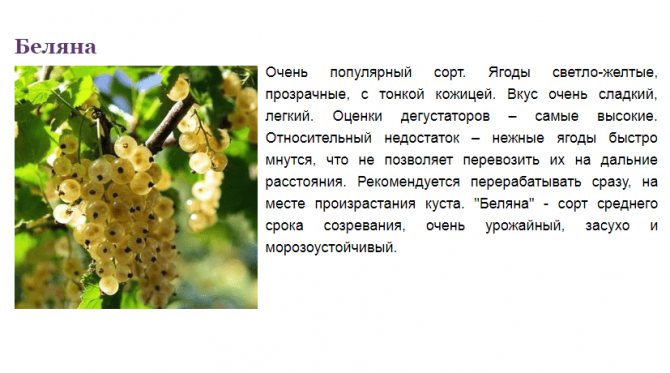

Dessert
Relatively large berries (up to 1.2 grams) of dessert taste appear in early summer. High frost resistance and the ability to fight diseases and pests ensure a stable good harvest. Berries with a delicate translucent skin look beautiful on a compact bush.
Control measures and folk remedies for aphids on currants are presented here.
Minusinskaya
This variety is distinguished by high winter hardiness, diseases and pests are not afraid of it. Annually pleases the owners with stable yields of delicious berries (4, points). Small berries (up to 1 gram) with a thin yellowish skin have large seeds.
Ural
The Ural white currant was specially bred for cultivation in the frosty Ural winters. Does not suffer from powdery mildew. The yellow sweet berries received the maximum taste rating (5 points).
Pearl
The variety does not have a high sugar content in berries, but remains among the leaders in consumer preferences. The bushes are medium-sized, with a fairly spreading crown and dense foliage. The berries are of an ideal spherical shape, large, painted in a coal-black color. Fruit pulp with a pronounced dessert taste and aroma.
| Harvest | Bush height (m) | Berry weight (g) | Productivity (kg per bush) | Shelf life of fresh berries (days) | |
| The beginning of June | 1-1,2 | 3-5 | 2,5-3 | 18-24 | |
By region
A wide variety of black currant varieties allows you to choose the best option not only in terms of yield, size or taste characteristics of berries, but also in terms of the rate of fruit ripening. When choosing black currants for self-cultivation, it is worth stopping at zoned varieties. This will allow you to get a good harvest without putting in incredible effort.
For Moscow region
Looking through the best varieties of black currant for the Moscow region, it is necessary to take into account not only the climatic features of the region, but also the composition of the soil. Its consumer characteristics will depend on the quality of plant care.
Nina
In terms of sugar content in berries (11%), Nina is only slightly inferior to the Otlichnitsa. It is a mid-early variety that bears fruit abundantly. Bushes are low, dense, form many basal shoots. The berries are quite large, up to 1.3 cm in diameter, round and one-dimensional. 100 g contains 180-270 mg of ascorbic acid, which is equal to 2-3 daily intake for an adult.
| Harvest | Bush height (m) | Berry weight (g) | Productivity (kg per bush) | Shelf life of fresh berries (days) | |
| Early July | 1,2-1,5 | 2-4 | 3-5 | 10-12 | |
Late, large
Berries taken from early ripening bushes have a low sugar content (about 10%), so there is a sour taste in the taste. Such fruits are often used for conservation. In this case, ascorbic acid acts as a natural preservative, which contributes to the preservation of the workpieces.
Ripens early, harvesting begins in the second half of July. The weight of one currant reaches 2-3 g. The color of the fruit is intense and dark. Despite the presence of sourness, among other early varieties, the sweetness is higher (9.1%).
The peculiarity of the shrub is the delayed discharge of ripe berries. After the technical ripeness, the currants remain on the branches for about 2 more weeks. After such drying in the sun, the peas are more reminiscent of raisins in appearance and taste. The plant is undersized, resistant to heat and prolonged cold snaps, immunity to ash and ticks is observed.
Ripe black currants look harmoniously on a tall plant. All as on the selection have the same shape and size. The weight of one is 7-7.5 g. The plant belongs to self-fertile crops. Among the advantages of the variety: high yield, frost resistance, pleasant dessert taste. Disadvantages: average resistance to kidney mites and septoria.
The bushes are characterized by a restrained type of growth, average fruit ripening. The berries are plum-shaped, the weight of one reaches 5-6 g, but there are also records of 8 g. The yield of an adult plant rarely drops below 3.7 kg. The dense pulp contains a lot of juice. The taste is sour, but pleasantly refreshing.
The climatic zone of Siberia and the Urals differs significantly from the central part of Russia. The average temperature in winter drops to minus 20. In some regions, it can drop below minus 35-40, and in summer it rises to plus 35 degrees Celsius. Strong winds prevail in winter.
There is little precipitation in flat areas, and snow does not melt in the mountains all year round. This climate is not suitable for all plants, so we recommend choosing specially cultivated and adapted seedlings for planting in these regions. Below you can see the best black currant varieties for Siberia and the Urals with photos and main characteristics.
The berries are poured up to 3.8 g, covered with a dense and shiny skin, practically not sweet, with a strongly pronounced sour taste. It is popular due to its high content of vitamin C (in a ratio of 1.76 mg per 1 g of fruit).
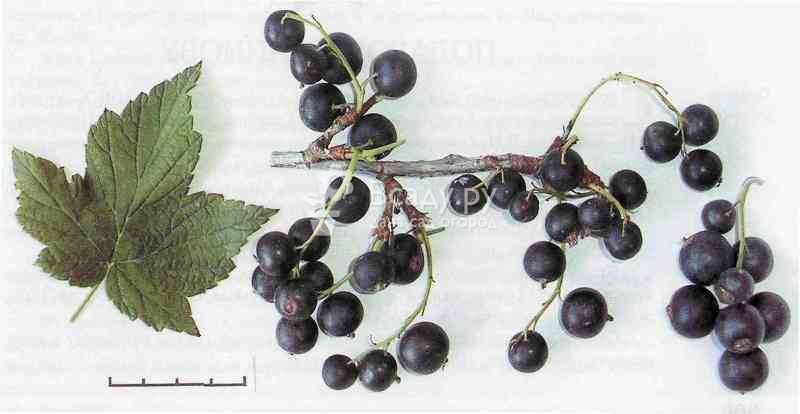

Large berries of black currant variety Gift to Kuzior
The bush is medium spreading, the branches are not thick, bears fruit in late July. The variety is resistant to summer heat and winter low temperatures, easily tolerates spring night frosts. Does not suffer from septoria, powdery mildew and anthracnose, resistant to the appearance of gall aphids.
Variety Spherical
The fruits of this species begin to ripen in early August, the berries are large (weighing 1.9-2.8 g), with sourness.


Black currant Spherical resistant to temperature extremes
The advantage of the Sharovidnaya variety is resistance to sudden changes in temperature, high yield (up to 3.6 kg of yield from one bush). The bushes do not get sick with powdery mildew, but they are not resistant to septoria and kidney mites.
Berries Prestige are large, ripe fruits, sweet and sour taste, have a refreshing aroma. This variety of black currant ripens at the end of July - August.


Harvest of currant berries Prestige for Siberia and the Urals
The bush is tall, with dense branches. Prestige easily tolerates hot weather and lack of rain in summer, low temperatures with strong winds in winter. The bushes are not susceptible to the main diseases and pests (powdery mildew, hazel grouse, gall aphid).
Meanwhile, berries that ripen closer to the autumn season are equally popular.After all, the longer the fruiting time of black currant, the more vitamins the body can receive, and also prepare it for the winter.
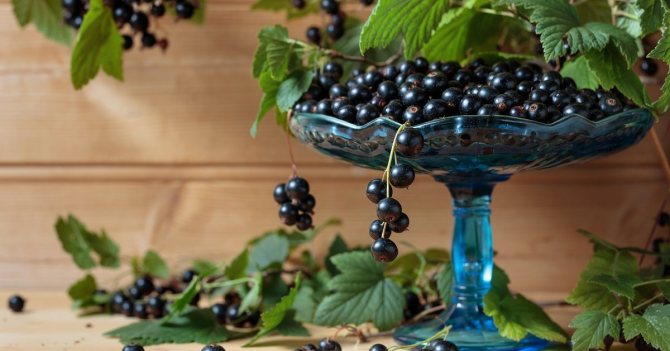

The shrub grows up to a meter in height. In this case, the branches are arranged vertically, do not spread out in different directions. The lower shoots do not need a garter. Fruits are of considerable size up to 2.5 g. The taste of berries is sweet with a small amount of acid. The separation is dry. The culture is self-fertile. It tolerates frosty winters well. It does not lend itself to attacks by a kidney mite, but it has no immunity from powdery mildew.
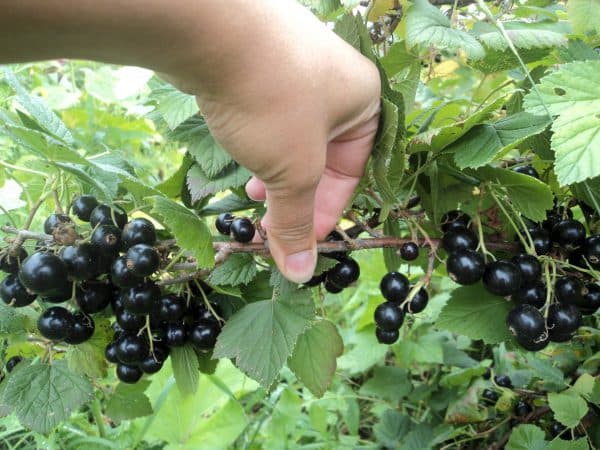

The harvest ripens with the arrival of August. Fruiting - 3-4 kg per bush.
Lazy person
The variety is Lazy, universal. The plant is tall up to 1.8 meters, branches are spreading, thick. The foliage is large, dark green. 8-9 berries are densely arranged on the cluster, weighing 3 g. Fruits are round in shape, dark brown in color. The taste is sweet. Tasting score 4.8 points. Productivity per bush up to 2 kg.
Katyusha
The plant is vigorous, but compact. Not afraid of cold weather and anthracnose. The berries are large and sweet. The skin is firm, therefore the variety is preferable for freezing and transportation. May be affected by kidney mites.
Vologda
A tall, thickened, spreading bush perfectly tolerates winter cold. Easily resists powdery mildew and kidney mites, but suffers from rust. Vologda will tell about currants of the variety
The berries are large, weight - 1.5-2 g. The separation is dry. The taste is sweet and sour. Productivity 3-4 kg. Self-fertility is high.
The disadvantages include: uneven ripening, the need to put props under the branches.
Venus
Designed for cultivation in the Urals, it is there that the highest yield. Winter hardiness is high. Easily tolerates dry weather. Sprawling, branched bushes. The average weight of one berry is 6 grams. The skin is thin. The variety is not susceptible to fungal diseases and parasites.
"Daughter"
Differs in late ripening. The bushes are not spreading, no more than a meter high. The fruits are large, with a dry separation, the weight of the fruits is from 1 to 2.4 g. The taste of the pulp is sweet and sour, 100 grams of currants contains 160 mg of vitamin C and 7.6% sugar. "Daughter" perfectly tolerates frost and drought. The variety is not susceptible to the appearance of a kidney mite.
Benefits:
- Productivity;
- Good quality berries.
Disadvantages:
- Medium powdery mildew resistance.
"Vologda"
Maturation occurs late. Medium-sized plant with sprawling bushes. The fruits are large, with a dry separation to the taste of sour-sweet. The pulp contains 7.6% sugar per 100 grams and 176 mg of vitamin C. "Vologda" tolerates low temperatures well, but spring frosts can have a negative effect on currants.
Benefits:
- High productivity;
- Large berries;
- It tolerates diseases well.
Minuses:
- The plant takes up a lot of space due to the large bushes;
- Needs additional supports.
"Lazy person"
Maturation occurs late. Bushes of the plant are dense and vigorous, height from 1.6 to 1.9 m. Fruits are large, round in shape. The pulp is sweet, contains about 118 mg of vitamin C per 100 g and 8.9% sugar. "Bummer" tolerates low temperatures well, is self-fertile. Not susceptible to the spread of diseases such as terry, anthracnose.
Benefits:
- Not susceptible to the spread of diseases and viruses;
- Has a dessert taste.
Minuses:
- Productivity of different volumes;
- Maturation at different times.
Dobrynya
It was bred in the city of Bryansk and received recognition from many gardeners in the country and neighboring countries. This is a large-fruited variety that requires very good care, the highest soil fertility. The harvest will depend on this. Relatively winter-hardy, feels better in drought conditions, resists spring frosts well. It is immune to powdery mildew and a number of other diseases. The bush is small, erect. The berries are very large, for which gardeners love this variety. The taste is sweet with pleasant sourness. This is one of the best large-fruited varieties.Don't forget that it's not just the berry that is healthy. Be sure to harvest fresh currant leaves for the winter in order to drink delicious tea in winter that will support immunity.
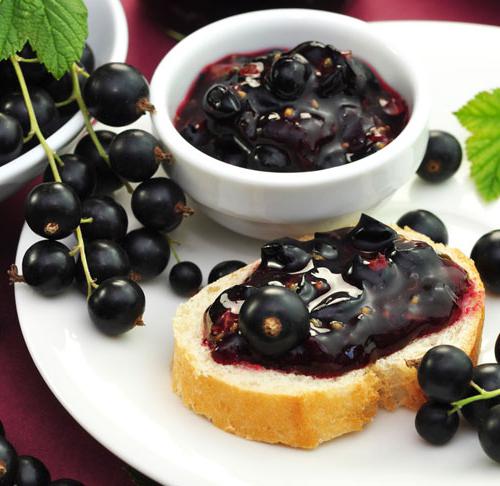

An excellent pupil
According to the results of many years of research carried out by specialists from the All-Russian Research Institute of Breeding of Fruit Crops, this variety is the top three in terms of sugar content in berries (11.1%). The bushes are quite vigorous, spreading and dense. Berries are coal-black in color, large, with a slight sourness. The variety is moderately hardy, resistant to returnable spring frosts. But his ability to withstand diseases and pests is average.
| Harvest | Bush height (m) | Berry weight (g) | Productivity (kg per bush) | Shelf life of fresh berries (days) | |
| Early July | 1,5-1,8 | 0,9-1,5 | 4-4,5 | 12-18 | |
Memory Michurin
, Does not freeze, there are always a lot of berries on it with tassels. The taste is normal. You can eat and make jelly.
Black currant variety. Winter-hardy and drought-resistant grape variety has an early ripening period. The bush is medium-sized in height, spreading in volume. The leaves are like grape leaves. Disease resistance is quite high, the variety does not lend itself to damage by anthracnose. Berries of good taste, with a thin skin are brownish-black in color. The separation of fruits is carrots. The harvest is harvested at the same time.
Growing regions: North and North-West, regions - Central, Volgo-Vyatka, Siberian and Far East.
Currant for open ground
In open ground, varieties are grown that are characterized by a high index of winter hardiness.
| Large-fruited category | |
| Name | Brief characteristics of the fruits |
| Sanuta | Tasting score - 4.0-4.5 points. Weight - 4-5.5 g, almost black color, round-elliptical shape. |
| Dobrynya | Form - oval, color - almost black, weight - 4.5-6.5 g. |
| Beauty of Lviv | Shape - round, color - shiny black, weight - 3.6-4.5 g. |
| Cherry | Taste - sweet and sour, tasting score 4.5 points. Weight - 2.2-2.5 g. |
| Early maturing category | |
| Name | Collection time harvest |
| Overture | mid June |
| Summer resident | end of June |
| Pigeon | second decade of June |
| Curiosity | mid June |
| Leader category in sugar content | |
| Name | Amount of sugar |
| Black BMW | 8,6% |
| Pearl | 9,3% |
| Raisin | 9,1% |
| Legend | 7,4% |
| Dessert category | |
| Name | Tasting assessment |
| Perun | 4.9 points |
| Venus | 5 points |
| Sweetheart | 5 points |
| Centaur | 4.6 points |
For greenhouses
When growing crops for commercial purposes, the method is used under cover, that is, in a greenhouse. This makes it possible to start harvesting a couple of weeks earlier than usual. Moreover, in case of abnormal frosts, it will be easier to save the plantation.
| For cultivation in greenhouses | |
| Variety name | Short description |
| The sweetest currant | |
| An excellent pupil | Sugar amount - 11.1%, weight - 1.2-1.5 g, yield per bush - 4 kg. |
| Bagheera | Sugar amount - up to 12%, weight - 1.1-1.6 g, yield - 3-4.4 kg. |
| Nina | Sugar amount - 11%, weight - 1.2-1.6 g, yield - 3-5 kg. |
| The largest currant | |
| Gulliver | weight - 3.2 g. |
| Venus | weight - up to 5.7 g. |
| Pygmy | weight - up to 7.5 g. |
One of the important criteria for the selection of a variety of currants, regardless of the characteristics of the climate in the region, is the equivalent ratio of yield and frost resistance. The safety of the bushes in the winter period largely depends on the quality of the autumn processing of plants and their preparation for frost.
For Mid Band
For the Central Lane of the country, many types of currants have been bred, which differ in terms of readiness and taste. You need to take a closer look at the varieties described below.
Summer resident
A variety with large fruits - the weight of currants is 2-5 grams. Sweet fruits - 9.3%. The skin is thin and delicate.
The summer resident ripens amicably, the branches often fall on the ground, the berries crumble to the ground. The crop must be harvested on time. Used for freezing, preserves, jams.
Exotic
Currants grow up to 3-5 grams, sugar content is highly dependent on soil and weather conditions. The berries are tasty and fragrant. The delicate hide often leads to damage and decay, so it is not worth transporting the crop.
Up to 3.5 kilograms of Exotics are harvested from the bush. Resists well against major diseases and pests.
Venus
Venus grows well in places with unstable weather, suitable for planting in the northern regions and the Baltic States.
The berries weigh 2.5-6 grams, they ripen uncommonly, you will have to harvest several times. Up to 5 kilograms of currants are obtained from the bush. The berries have a thin skin and taste good.
They easily tolerate frosts down to -35 °, they do not need insulation.
Favorite
Favorite berries have a thin skin and a weight of 3-4 grams. Fruits ripen by the end of July.
Productivity - up to 3.5 kilograms per bush. The plant keeps its shape well, even when covered with berries.
Selechenskaya
This is one of the most popular varieties, which even received a "reissue" (not so long ago, the Selechenskaya 2 variety was received). One of the factors that allowed the variety to spread in most regions was its high adaptability to weather and climatic conditions. Bushes vigorous, straight, with a small crown.
| Harvest | Bush height (m) | Berry weight (g) | Productivity (kg per bush) | Shelf life of fresh berries (days) | |
| Beginning - first decade of July | 1,3-1,5 | 2-4 | 2-3 | 12-16 | |
Reviews of summer residents


Alexey Petrovich, Stupino
In the yard he laid out a small garden with 9 trees and 15 currant bushes. For 7 years I tried to grow different varieties of the Kryzhovnikov family. The Little Prince and the Summer Resident have shown themselves well. A feature of these varieties is considered to be abundant and timely watering. Black currant bears fruit annually; with proper pruning, the young plant gives a large increase in yield.
Maria, Valtsovo
The whole family is very fond of black currant jam. Neighbors in the country have been growing a culture for a long time, experimenting with varieties. For some reason, the plant does not take root in me. Several years ago we managed to acquire several Sudarushka bushes.
From my poor experience, I can say that currants are very fertile and winter hardy. I, of course, insulate the trunk circle in the fall, and carefully sanitize it. But after the record frosts of the last winter, the powerful immunity of the plant itself is felt.
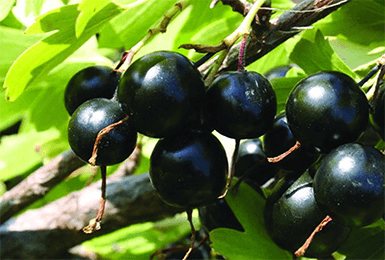

Tamara Alexandrovna, Staraya Sitnya
From currants grown in my summer cottage, I close compotes, jams, add red berries to tomatoes when canning, try various impromptu with confiture. In our area, black-fruited varieties have taken root very well: Yadrenaya, Dobrynya, Veloy. The twigs are literally covered with beautiful berries.
Found a mistake? Select it and press Ctrl Enter to tell us.
conclusions
- In central Russia, you can grow many varieties of currants. For areas with a temperate continental climate, you can choose plants of European selection. For regions with colder winters and hot summers, varieties of Siberian selection are suitable. Read about the best varieties for Siberia.
- It is preferable to choose zoned currant modifications for planting.
- Different varieties differ in terms of ripening and characteristics of berries. As a rule, gardeners try to plant several options that allow them to get berries all summer.
- Early currants ripen by mid to late June. Its taste is not so pronounced, its size is average. Such a berry has a thin skin, so currants cannot be stored.
- Medium varieties have a much brighter taste and strong aroma. The size of the berries is larger, the skin is thicker. Berries can be eaten both fresh and used for preservation.
- Late currants gain maximum sugar and ascorbic acid over the summer. Usually late berries are the largest and sweetest. At the same time, they adhere well to the branches, are perfectly transported and are suitable not only for making jam, but also for drying.

